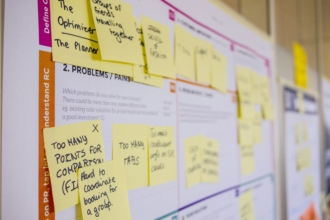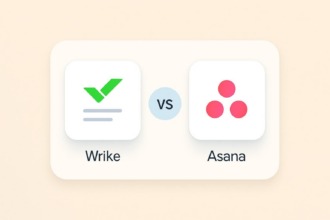Whether you’re throwing in a load of laundry or leaving the dishes for tomorrow, you’re already managing tasks — just on a small scale. Task management is something we all do. But when applied intentionally and at scale, it becomes a powerful tool for boosting productivity and driving business success.
“The task management life cycle includes steps like planning, tracking, execution, and a compilation of your success after a project or group of tasks has been completed,” says Travis Haninger, chief commercial officer at PinPoint Surgical. “When done right, it can transform your organization’s productivity and growth.”
Effective task management is more than checking items off your to-do list — it’s about creating systems that help individuals and teams stay focused, aligned, and efficient. How can you get started with task management? Let’s start by defining the term.
What is task management?
Task management is the process of managing your tasks from inception to completion in order to finish them within the deadline and budget set by you or a third party. Ultimately, you have to decide whether to complete, delegate, or abandon scheduled tasks.
When we break down each task management stage, we gain a clearer picture of what it entails:
- Planning: Defining a task, setting its priority level, and assigning an owner
- Tracking: Monitoring the progress of a task as it moves through the life cycle
- Executing: Performing the work required to complete a task
- Reviewing: Learning from the work performed by analyzing metrics like time, effort, and relevance
In the workplace, task management can blend into work management. For example, projects at the team level can typically be broken down into smaller steps or tasks to be handled at the individual level. Let’s dig deeper and examine the differences between task and work management.
Task management vs work management
Task management focuses on handling individual tasks efficiently — tracking deadlines, setting priorities, and managing dependencies. It’s about staying organized and ensuring each item on your to-do list gets done. This approach works well for individuals and small teams who need to manage day-to-day responsibilities and short-term goals.
Work management, by contrast, takes a broader view. It includes task management but also integrates project planning, resource allocation, team collaboration, and performance tracking. It’s designed to coordinate larger initiatives and complex workflows across departments or entire organizations.
“Tasks are the building blocks of all work,” says Haninger. “Every team, project, or program is built from a series of tasks, and the ability to track and compile those tasks is essential to the completion of the project. In this way, task management and project management can be symbiotic.”
While task management is a part of work management, it’s not a replacement — and not all tasks are tied to a specific project. Operational work, like responding to emails or updating internal documentation, still needs structure — and that’s where task management shines.
In short:
- Task management is about doing the work
- Work management is about orchestrating the work
Why is task management important?
Effective task management helps individuals and teams stay focused, organized, and aligned. Here are five key benefits:
- Increased productivity: Task management keeps priorities clear and distractions in check. By outlining what needs to be done, and when, people spend less time figuring out their next move and more time executing it.
- Better organization: Centralized task lists, deadlines, and status updates help prevent important work from slipping through the cracks. Whether you’re juggling multiple projects or daily responsibilities, everything stays visible and trackable.
- Improved time management: Breaking work into smaller tasks makes it easier to estimate time, set realistic goals, and avoid last-minute rushes. Task management also helps identify bottlenecks early so you can reallocate time and resources as needed.
- Enhanced collaboration and transparency: When everyone knows who’s responsible for what, teams move faster and communicate more effectively. Task management tools also streamline handoffs and keep everyone on the same page.
- Reduced stress and burnout: A clear plan helps you visualize tasks and understand when a workload is becoming unbalanced. Instead of reacting to tasks as they come, you can work proactively, which leads to more control and less anxiety.
Top task management methods and methodologies
How you actually manage your tasks will depend on which of the task management methods you adopt, and the method you choose will depend on the task management methodology that you think best applies to the work you do.
Task management methodologies vs task management methods
Task management methods are built to execute day-to-day tasks based on the principles of a task management methodology. Let’s define each term:
- Task management methodologies are theories of how to complete work, based on a defined set of principles.
- Task management methods are frameworks for how to manage day-to-day tasks, following the principles of the overarching task management methodologies.
Task management methodologies
Agile and waterfall are the two most popular task management methodologies. Agile is built on principles of iterative work, or a “plan-as-you-go” mindset, whereas waterfall is built on principles of work in a timeline, or a “start to finish” mindset.
Agile
Agile is a task management methodology with roots in software development. It promotes continuous iteration through testing throughout the life cycle of a project. When you implement Agile, both testing and measurement happen simultaneously.
“Agile task management is typically applied in a project setting,” says Graf. “Say you have a deadline to complete a project between now and the end of the year. Agile says that you have a set of business problems to solve in a certain amount of time, so break it down into smaller chunks. After each chunk (or set of tasks) is complete, let’s take a step back, see how we did, and reprioritize.”
Breaking out a project into chunks of work, or sprints (which we’ll cover more in depth later), allows you to review work with stakeholders as you go, so there are never misalignments or surprises at the end of a project.
Waterfall
Waterfall is a direct competitor to agile and emphasizes a linear progression from the beginning to the end of a project. This methodology requires careful planning at the beginning of a project, detailed documentation as you go, and consecutive execution throughout the life cycle to meet deadlines.
“While it’s less popular than agile, there’s nothing wrong with using waterfall when the type of work that you’re doing is predictable,” says Pourkermani. “For example, I can manage the process of making a cup of coffee in the morning quite predictably. I input the coffee beans, use the grinder, boil water, and pour my cup.
“But if my project is more complex, like redecorating a room in my home, I might prefer agile to better manage surprises like orders that are delayed, curtains that aren’t quite the right color or size, or any other roadblock.”
When you apply waterfall, changes to a complex project can become expensive and time-consuming as you often have to backtrack and redo tasks to handle unexpected issues.
Task management methods
Several task management methods can carry out the principles of the two most common methodologies.
Kanban
Kanban task management is part of the agile methodology. It’s a visual method for managing tasks through the use of cards moved between life cycle stages as a project progresses. Pronounced “kahn-bahn,” kanban gets its name from the original Japanese translation, “visual signal” or “card.”
“There are certainly other methods, but I don’t believe any of them are as good as kanban when it comes to bringing visibility into where work is, how it’s progressing, and how far it needs to go before completion,” says Pourkermani.
Graf describes the visual experience of Kanban using a metaphorical swimming pool. Each lane is a life cycle stage between ideation and completion for each task. As you complete each stage, you move your card from lane to lane.
“Kanban was originally managed using Post-it notes on a board, but nowadays, many digital tools can mimic it,” says Haninger.
Here’s an example of a Jotform Boards that helps teams collaborate and manage projects more efficiently with a Kanban-style workflow.
Scrum
Scrum is the most popular method to carry out the principles of agile. Users complete tasks in short blocks of time, called sprints, which usually range from two weeks to one month.
After each sprint, you collect feedback, measure progress, and select or adapt the next set of tasks based on what you learned in the sprint.
Getting Things Done (GTD)
GTD task management can adapt to the principles of either agile or waterfall, depending on how users execute it. GTD is the process of recording every task, request, or ticket in one master list and working on methodically completing those tasks until your list is empty.
“GTD is most appropriate for individuals or small teams,” says Graf. “You record any task that comes your way and constantly review and prioritize your tasks based on that big list. You could do this following the principles of agile, by completing chunks of tasks at a time, or you could plan them all at once, following the principles of waterfall.”
Lean portfolio management
Lean portfolio management is a task management method that follows the principles of waterfall. Its roots are in manufacturing, and it focuses on completing an entire project from start to finish using the least amount of resources possible, including both raw materials and human resources.
In the next chapter, we’ll learn that while some of these methods have roots in one specific business department, you can carry out all of them across your organization.
5 tips to improve your task management skills
Strong task management starts with simple, repeatable habits. These five task management tips can help you take control of your workload and stay on top of your priorities:
- Use your calendar to assess your daily capacity: Don’t overload your to-do list without considering your actual availability. Check your calendar before committing to tasks so you can match your plans with your time and energy for the day.
- Use time blocking to accomplish key tasks: Set aside dedicated time blocks on your calendar for high-priority work. Blocking time helps reduce distractions and gives you a clear window to focus more fully on what matters most.
- Leverage rules and automation to reduce manual follow-up: Whether it’s setting reminders, automating recurring tasks, or triggering the next steps in your workflow, automation takes the busywork out of task management and ensures nothing slips through the cracks.
- Schedule a daily check-in to review and reset: A short, consistent review — even just five minutes — can help you organize new tasks, reprioritize, and remove outdated items. A clean task list is easier to follow and less stressful to manage.
- Use task management software: Digital tools like Jotform Boards make it easier to organize tasks, visualize deadlines, and collaborate with others. The right task management platform gives you visibility, accountability, and automation — all in one place.
What is task management software?
Task management software is a digital tool (or a combination of multiple tools) that helps individuals and teams plan, organize, and track tasks more efficiently. It replaces spreadsheet- or paper-based to-do lists with interactive features like boards, calendars, deadlines, priorities, and progress tracking. Whether you’re doing solo work or managing team tasks, this type of software makes it easier to stay aligned and on schedule.
Modern platforms may also integrate with the existing apps you use, automate workflows, and offer built-in collaboration tools.
Benefits of task management software
Below are some key advantages of using task management software.
- Resource management: Allocate people, time, and tools effectively across tasks and projects to avoid overloading team members or underutilizing key resources.
- Budget management: Track task- and project-level costs to stay within budget. Many platforms support cost estimates, actuals, and financial reporting tied to work progress.
- Accountability: Assigning tasks with clear owners and deadlines creates transparency and encourages follow-through. Everyone knows who’s responsible for what and when it’s due.
- Real-time progress tracking: Dashboards, checklists, and status updates give instant visibility into how work is progressing. This makes it easier to spot blockers, adjust priorities, and keep projects on track.
- Improved decision-making: With centralized data on workload, progress, and timelines, managers can make smarter, faster decisions backed by real-time insights instead of guesswork.
How to pick the best task management software
The right task management software depends on how you and your team work. Instead of picking the most feature-rich tool, focus on what will support your day-to-day workflow. Consider these key factors:
- Ease of use: If the tool isn’t easy to adopt, your team won’t use it. Look for a clean interface, drag-and-drop functionality, and simple onboarding.
Example: Jotform Boards is great for teams that want a visual layout with minimal setup. You can start with a simple board and expand as needed.
- Collaboration features: Task management should include features that make collaboration easier for teams. Built-in comments, mentions, shared boards, and real-time updates are essential for teams working remotely or across departments.
Example: Asana lets you assign subtasks, tag teammates, and share updates without switching between tools like email or chat.
- Customization: Every team has its own workflow, and rigid software can quickly become a bottleneck. Look for tools that let you rename fields, set task dependencies, create custom workflows, and filter tasks in ways that make sense to you.
Example: ClickUp offers deep customization, from unique task statuses to user-specific dashboards, which is great for teams with more complex needs.
- Task visualization: The ability to switch between list, board, calendar, and timeline views helps accommodate different work styles.
Example: monday.com allows you to toggle between kanban boards, timelines, and calendars, which is especially useful for project managers juggling multiple workstreams. Though it should be noted that there are some other alternatives which allow the managers to achieve the same thing.
- Integrations: Your task tool should work with your existing tech stack, not add to your workload. Integrations with tools like Slack, Google Calendar, and Zoom can reduce context switching and automate updates.
Example: Notion integrates with Google Drive, Slack, and GitHub, making it ideal for hybrid teams managing documentation and tasks.
- Reporting and analytics: Clear reporting helps team leaders and stakeholders track progress without micromanaging. Look for tools that display metrics like task completion rates, workload distribution, and overdue tasks.
Example: Wrike offers built-in analytics and custom dashboards that give managers visibility into team performance at a glance.
- Pricing: Start with what you need, not the biggest plan. Many tools offer free tiers that cover core features, which is perfect for small teams or testing. Just make sure you understand what features are locked behind paywalls as your needs grow.
Example: Todoist is free for personal task management but requires a paid plan for team collaboration or advanced filters.
By matching software features to your real-world workflow, you’ll be more likely to adopt the tool, use it consistently, and actually benefit from it.
How to use task management software
Task management software helps you bring structure, clarity, and accountability to daily operations — making collaboration and execution more efficient. Use these common scenarios below to identify what you might need it for.
1. Task assignment and tracking
Task management software allows businesses to assign responsibilities and track progress transparently. They rely on the software to delegate work based on team capacity, skill sets, and deadlines, helping managers avoid bottlenecks and reassign tasks as priorities shift.
- Example: In a sales team, managers can assign follow-ups, demo calls, and lead-nurturing tasks with due dates and statuses. Using the Sales Pipeline Board Template, they can visualize the progress of each lead and avoid missed opportunities.
- Related Jotform Boards features: Custom columns, drag-and-drop interface, status tracking, and assignee fields.
2. Collaboration and communication
Effective collaboration is about creating a shared workspace where team members can exchange context, give feedback, and stay aligned without relying on scattered tools. Rather than bouncing between emails and chats, task management software enables teams to comment directly on tasks, tag teammates, and attach relevant files or links in one place.
- Example: A marketing team running a campaign can collaborate on creative assets, campaign messaging, and approvals in a single workspace using the Marketing Campaign Board Template. Each task has space for notes, attachments, and team comments.
- Related Jotform Boards features: In-task commenting, file uploads, mentions, and a mobile-friendly interface.
3. Prioritization and deadlines
Not all tasks carry the same weight, and without a clear system for setting priorities and deadlines, teams can easily fall into reactive work and miss critical milestones. Task management software allows teams to organize work by urgency, importance, due date, or strategic impact, helping them focus on what moves the needle.
- Example: Requests for IT support constantly come in. Using the Incoming Requests Board Template, IT teams can prioritize urgent tickets, assign technicians, and track issue resolution from a centralized view.
- Related Jotform Boards features: Custom priority tags, due dates, filters, and color-coded labels.
4. Workflow automation
Manual follow-ups, status updates, and repetitive admin tasks can quietly drain time and attention, especially as teams grow and projects scale. Whether it’s sending a reminder when a task is overdue, auto-assigning new submissions, or updating statuses when conditions are met, task management automation ensures tasks move forward with minimal friction — freeing teams to focus on high-impact work.
- Example: An human resources department managing a new hire’s onboarding can automate tasks such as sending welcome packets, scheduling training, and collecting paperwork using the Employee Onboarding Board Template.
- Related Jotform Boards features: Automated emails, form integrations, and approval workflows.
5. Progress monitoring and reporting
Without visibility into how work is progressing, it’s difficult to make informed decisions, adjust timelines, and identify issues. Real-time tracking and reporting tools help managers and stakeholders understand where things stand, not just at the task level but across entire projects and teams.
- Example: A project manager overseeing cross-functional initiatives can use Boards to see how many tasks are completed, which are overdue, and which team members are at capacity. The Project Plan Board Template provides a structured overview that supports better decision-making.
- Related Jotform Boards features: Real-time views, visual progress tracking, and exportable data for reporting.
Leverage task management software for productivity
The right task management software helps you capture, organize, and act on tasks with greater structure and consistency. Features like automated task creation, visual organization, real-time updates, and app integrations ensure your task management process works with your workflow, not against it.
How Jotform Boards makes task management smarter
Jotform Boards is a flexible, kanban-style task management platform that helps individuals and teams manage tasks visually and freely. Let’s consider a few ways it lets you do task management your way.
Manual and automated task creation
You can create tasks manually by building a board from scratch using columns, custom fields, and drag-and-drop organization. What’s more, you can automate task creation by connecting your boards to the systems where work begins.
Form integrations allow you to turn submissions into tasks automatically. Whether you’re collecting job applications, customer inquiries, or IT requests, those form entries become structured tasks ready for follow-up.
A single form can feed into multiple boards, or multiple forms can populate a single board — giving you control over how data flows through your processes without duplicating or altering original submissions.
AI-powered task generation
Jotform Boards lets you deploy AI agents that can create tasks from real-time conversations or user actions. For example, when a customer places an order or submits a support ticket through a chatbot, the AI agent can automatically generate a task in the appropriate board.
You can set it up so that one agent creates tasks in multiple boards or that multiple agents feed into a single shared board. This is especially useful for support teams, operations, or any workflow that begins with a customer request.
Workflow integration
As your workflow progresses, Jotform can automatically create tasks at relevant stages, keeping execution aligned with planning.
You can link several workflows to a single board to centralize task creation or use one workflow to automatically create tasks in multiple boards if different teams or processes are involved. Automation in the workflow ensures nothing gets missed as your process moves forward.
Visual and flexible collaboration
Jotform Boards feature a visual kanban layout with drag-and-drop functionality, allowing teams to shift tasks between stages quickly. Key collaboration features include
- Search and filter tools for easier task navigation
- Fields like Priority, Tags, Due Date, and Description for structured task tracking
- Real-time commenting, task assignments, and activity logs to keep teams aligned
- Mobile responsiveness so teams can manage work from anywhere
With powerful customization options like editable task layouts, configurable board stages, and even brand-aligned background themes, Jotform lets you adapt your task management software to your workflow.
Bring clarity to your organization
At its core, task management is how organizations turn intent into impact. It’s the connective tissue between strategy and execution — how big goals are broken down, delegated, and delivered. Whether you’re responding to a customer request, launching a product, or onboarding a new hire, it’s the everyday tasks that quietly determine your company’s success.
And unfortunately, there’s no one-size-fits-all approach. The key is finding a system that aligns with your team’s workflow, adapts to your needs, and supports the way you communicate and deliver value.
As organizations embrace digital transformation, task management tools have evolved to offer real-time visibility, automation, and cross-functional collaboration. Platforms like Jotform Boards help structure your processes and keep deadlines visible.
Ultimately, effective task management isn’t just about doing more — it’s about doing the right things with clarity and purpose.
Meet your task management guides
Travis Haninger
Travis Haninger is the chief commercial officer at PinPoint Surgical, a MedTech growth partner that fosters networks in the neuro and spine space.
He specializes in repurposing teams, developing programs, and digitally transforming departments to better serve customers and increase profitability. Task management tools play a significant role in the success of these business transformations.
Saman Pourkermani
Saman Pourkermani is the managing director at Tegria, a global healthcare consultancy that delivers end-to-end solutions to help providers transform their industry.
Pourkermani is an expert in lean-agile transformation, improving team performance, collaboration, and team throughput, implementing kanban, and improving team task management. He holds undergraduate and graduate degrees from the University of Chicago in computer engineering and management information systems.
Andrew Graf
Andrew Graf is the chief product officer for TeamDynamix, an information technology services and consulting company that makes data synchronization easy. He focuses on project portfolio management, system integration, and workflow.
Graf has been innovating in these areas for over 20 years and is well versed in task management topics and methodologies, including kanban, waterfall, agile, and emergent digital workspaces.

























Send Comment: